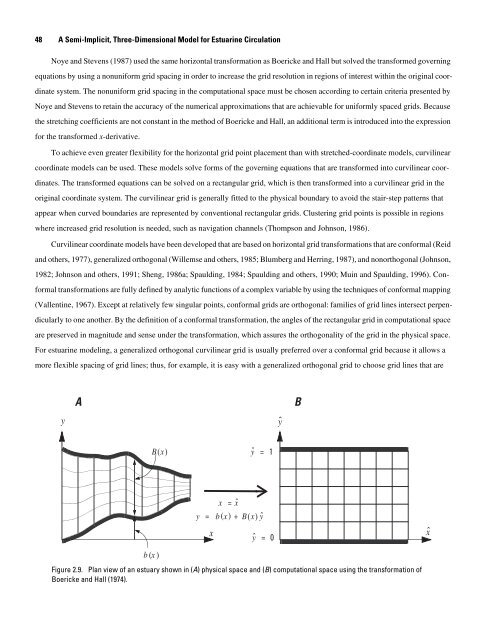A Semi-Implicit, Three-Dimensional Model for Estuarine ... - USGS
A Semi-Implicit, Three-Dimensional Model for Estuarine ... - USGS
A Semi-Implicit, Three-Dimensional Model for Estuarine ... - USGS
Create successful ePaper yourself
Turn your PDF publications into a flip-book with our unique Google optimized e-Paper software.
48 A <strong>Semi</strong>-<strong>Implicit</strong>, <strong>Three</strong>-<strong>Dimensional</strong> <strong>Model</strong> <strong>for</strong> <strong>Estuarine</strong> Circulation<br />
Noye and Stevens (1987) used the same horizontal trans<strong>for</strong>mation as Boericke and Hall but solved the trans<strong>for</strong>med governing<br />
equations by using a nonuni<strong>for</strong>m grid spacing in order to increase the grid resolution in regions of interest within the original coor-<br />
dinate system. The nonuni<strong>for</strong>m grid spacing in the computational space must be chosen according to certain criteria presented by<br />
Noye and Stevens to retain the accuracy of the numerical approximations that are achievable <strong>for</strong> uni<strong>for</strong>mly spaced grids. Because<br />
the stretching coefficients are not constant in the method of Boericke and Hall, an additional term is introduced into the expression<br />
<strong>for</strong> the trans<strong>for</strong>med x-derivative.<br />
To achieve even greater flexibility <strong>for</strong> the horizontal grid point placement than with stretched-coordinate models, curvilinear<br />
coordinate models can be used. These models solve <strong>for</strong>ms of the governing equations that are trans<strong>for</strong>med into curvilinear coor-<br />
dinates. The trans<strong>for</strong>med equations can be solved on a rectangular grid, which is then trans<strong>for</strong>med into a curvilinear grid in the<br />
original coordinate system. The curvilinear grid is generally fitted to the physical boundary to avoid the stair-step patterns that<br />
appear when curved boundaries are represented by conventional rectangular grids. Clustering grid points is possible in regions<br />
where increased grid resolution is needed, such as navigation channels (Thompson and Johnson, 1986).<br />
Curvilinear coordinate models have been developed that are based on horizontal grid trans<strong>for</strong>mations that are con<strong>for</strong>mal (Reid<br />
and others, 1977), generalized orthogonal (Willemse and others, 1985; Blumberg and Herring, 1987), and nonorthogonal (Johnson,<br />
1982; Johnson and others, 1991; Sheng, 1986a; Spaulding, 1984; Spaulding and others, 1990; Muin and Spaulding, 1996). Con-<br />
<strong>for</strong>mal trans<strong>for</strong>mations are fully defined by analytic functions of a complex variable by using the techniques of con<strong>for</strong>mal mapping<br />
(Vallentine, 1967). Except at relatively few singular points, con<strong>for</strong>mal grids are orthogonal: families of grid lines intersect perpen-<br />
dicularly to one another. By the definition of a con<strong>for</strong>mal trans<strong>for</strong>mation, the angles of the rectangular grid in computational space<br />
are preserved in magnitude and sense under the trans<strong>for</strong>mation, which assures the orthogonality of the grid in the physical space.<br />
For estuarine modeling, a generalized orthogonal curvilinear grid is usually preferred over a con<strong>for</strong>mal grid because it allows a<br />
more flexible spacing of grid lines; thus, <strong>for</strong> example, it is easy with a generalized orthogonal grid to choose grid lines that are<br />
y<br />
A B<br />
Bx ( )<br />
bx ( )<br />
x<br />
x = xˆ<br />
yˆ = 1<br />
y = b ( x ) + B ( x)yˆ<br />
yˆ = 0<br />
Figure 2.9. Plan view of an estuary shown in (A) physical space and (B) computational space using the trans<strong>for</strong>mation of<br />
Boericke and Hall (1974).<br />
yˆ<br />
xˆ

















